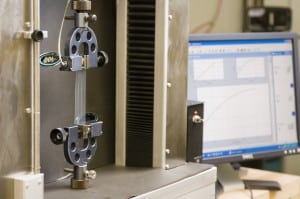Multiple industries utilize and rely on internationally accepted test standards to provide repeatable methods for comparison and quality assurance purposes. Rapid advancements in the film manufacturing industry have magnified the need to recognize the fact that tensile test methods may have small nuances that can lead to varying results if they are not paid proper attention.
 In a series of blog posts adapted from a recent article by Amy Peterson of DDL, we will discuss some of the common problems that can occur with some common test procedures such as tensile, tear resistance, puncture resistance and coefficient of friction, and how these factors can be minimized and eliminated and thereby assure the best test results possible for the film manufacturer. The first blog post will focus on common problems associated with Tensile Testing.
In a series of blog posts adapted from a recent article by Amy Peterson of DDL, we will discuss some of the common problems that can occur with some common test procedures such as tensile, tear resistance, puncture resistance and coefficient of friction, and how these factors can be minimized and eliminated and thereby assure the best test results possible for the film manufacturer. The first blog post will focus on common problems associated with Tensile Testing.
Tensile testing is one of the main physical procedures performed on films. ASTM D882 Standard Test Method for Tensile Properties of Thin Plastic Sheeting is one of the most common industry standards for thin sheeting and films, where thin sheeting is defined as less than 1 mm in thickness. This test standard contains a standardized method for determining mechanical properties such as tensile strength, percent elongation, yield stress and Modulus of Elasticity used in engineering design.
ASTM D882 specifies test parameters based on the material behavior. By using the percent elongation at break, the standard specifies the appropriate initial strain rate and sample dimensions to use for testing. This is an exploratory step and will often require extra material to accomplish. By performing this step, the user ensures the proper strain rate is utilized and in compliance with the standard allowing for repeatable results.
It is important to provide sufficient material in order to accommodate the required sample length in addition to the extra needed for the exploratory set up. It is also important to properly label the machine and transverse directions for the sample material since many of the properties will be different in each orientation.
During sample preparation, ensure clean sample edges without any defects. Defects in the edges will cause premature failures at the site of the defect and lower force and elongation values. Determine the material properties of interest such as tensile strength, percent elongation, Modulus of Elasticity and yield strength ahead of time to prevent having to reanalyze the data after the test has been completed. It is also important to use appropriate grips and grip faces to minimize breakage at the grips or slippage.